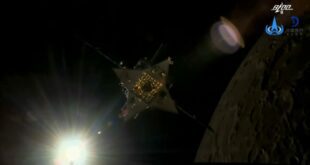
By Bleddyn Bowen
Headlines have again been made by a state testing a direct-ascent anti-satellite (DA-ASAT) weapon system. Russia’s flight test of its Nudol missile technology (which some claim is more for missile defence) falls into a wider and longer-term pattern of DA-ASAT weapons testing and development which has seen the United States, China, and India conduct similar flights over the last 15 years.
As is often the case, such activities can generate a storm of commentary on US social media, despite the fact that this test by itself is unremarkable when placed in the context of the continuing proliferation of military space technologies across Earth’s major military powers. Not least in this case as this is merely the latest in a string of Russian flight tests since 2014. Curiously, the United States Space Force, still in its infancy, decided to make a statement condemning this test despite the US Government allowing previous Russian tests to pass unremarked.

On the political level, some views are entirely too predictable and turgid where blame for ‘militarising space’ or ‘destabilising’ the international environment is cast around with no consideration for the actions of other states in promoting, enabling, or tolerating such activities, or even conducting it themselves when such criticism comes from the officials of space weapon testing states.
Such criticism tends to ignore the fact that space has been used for military purposes since the dawn of the Space Age and that a collection of major space powers have comparable piecemeal anti-satellite weapon development projects in motion with seemingly no appetite to prohibit this kind of weapon testing.
Other views tend to gravitate towards the strategic and military implications of such weapons technologies. Stating that space is the ‘ultimate high ground’ is a particular favourite among military space writers and the many space practitioners I engage with. It is a strong rhetorical move. It exudes an impression of authority as many specialist concepts do yet the claim falls apart when you think through what it means in practice and how high grounds actually work (or not) in strategy and warfare.
In June my book War in Space: Strategy, Spacepower, Geopolitics will be released by Edinburgh University Press. I try to address many recurring misconceptions about military space strategy, including the inescapable metaphor of outer space as the ‘ultimate high ground’ of future warfare.
Space as a High Ground
Capturing and holding a high ground usually means that you gain some advantages over your adversary by possessing ‘good ground’, good defensive positions, or places to launch efficient offensives from. Space weapons (whether Earth or space based) are often seen as methods of seizing or denying the control of this high ground: exploiting it for one’s own benefit through the support services and intelligence gained by space-based systems for terrestrial military forces, or denying that to the enemy.
Space systems in orbit undoubtedly provide important services and military advantages to modernised terrestrial military forces. Some would struggle to do without these services today. But the ‘ultimate high ground’ moniker is used as way to justify or imply that defending assets in space is needed at all costs, where if secured or a preferred technological system is invented, victory is sure to follow.
Not everyone who uses the ‘high ground’ concept does believe so of course, and some are more careful in its use, but it is a frequent implication and intellectual dead-end that I have encountered where many seem to treat the space dominance or control as an all-or-nothing affair.
America would no doubt have quite the crisis on its hands if it lost the use of space in its entirety. But short of nuclear war, it is unlikely to face a complete breakdown in its use of the ‘high ground’ of Earth orbit. The inverse is also true. The US cannot assume that the use of specific parts of space will remain uncontested even though it may enjoy a relatively high degree of space control. This is a well-established point already in official space doctrine and policy, so it is worrying to see contrary points perpetuated in some circles.
The Banality of the High Ground

The problem with the high ground concept is that in practice it just means somewhere where there’s an advantage to be gained. The high ground is a banal and generic idea that can be applied to almost anything that provides an advantage, and is often used to over-hype the decisiveness of controlling or denying space in warfare. Space is important and really useful, in some specific campaigns even essential, but it exists in a far larger political, strategic, technological, and geographic context that space cadets need to take into account.
A more important problem with the high ground idea however is the limitations of controlling a high ground. By itself, it does not provide cheap or easy victories. Readers of military history will know that holding good positions is no guarantee of ultimate strategic success. The French Army learned that lesson all too well in 1870 when the Prussians negated their positions magnifique by fighting around them and encircling them.
Intelligent and determined adversaries will find ways to undermine or counteract the advantages you derive from any ‘high ground’, especially if you do not work to exploit the advantages that the high ground gives you in other operations and follow-on actions.
Undermining of the advantages provided by spacepower is demonstrated in global trends towards counterspace, deception, concealment, adaptation, and dispersal in terrestrial military forces. The US military is now doing this itself in response to the space-enhanced military modernisation of China and Russia’s armed forces and their proliferating arrays of precision-strike weapons which rely on space-based infrastructure.
High grounds need a lot of other things to go right to be significant: logistics, morale, political support, competent command, incompetent enemies, timing, and no small amount of luck. The battles of Sevastopol, Gettysburg, Isandlwana, Ondurman, and Rangiriri come to mind as examples here. In an abstract sense, the ‘high ground’ of space is no different – you need effective capabilities in terrestrial environments and a suitable strategy (among many other things) to make sure you get the political outcome you want.
Successive American, Israeli, British, and Russian military upsets in the 21st century should be plain enough to demonstrate that principle of assured space control failing to prevent political upset or strategic failure.
Controlling the Cosmic Coastline
In short, controlling space by itself does not give you a decisive control of Earth. Dominating space will not give you victory by itself, but it is certainly useful. Continuing to operate in a degraded space environment or without all your assets is more important still. Invoking half-baked and linearly implemented metaphors of positional warfare does no justice to the practical chaos of strategy, not least of all in space.
The advantages provided by controlling space need to be consciously exploited in the other environments on Earth. Spacepower’s effects from orbit can be blunted as well as exploited in Earth’s other environments. Space is something of a cosmic coastline, or a littoral environment, or orbital flank. It is not an ocean, which tends to be distant, isolated, and only controllable by having a presence in that environment.
Coastlines are nearby, as Earth orbit is to Earth. Events on Earth will impact what happens in orbit, and weapons fire can be projected from Earth into orbit. This is analogous to how land powers can project their influence from the land into their coastal regions and deny free reign to any fleets. Similarly, there can be terrestrial workarounds to orbital problems in the same way armies could attack land targets to support coastal naval operations – why attack a satellite when you can bombard a satellite ground control station instead? This coastal analogy is substantiated much further in the book, and also engages with the limitations of the analogy. All analogies break at some point, of course.
David v Goliath
Like the coasts, Earth orbit is not the sole preserve of one or a small handful of space powers. Earth orbit is populated by a range of state and non-state actors, many of which provide useful services and data for warring parties. The proximity of Earth orbit to the primary theatres of Earth itself provides more opportunities for smaller actors to meddle and work around enemy orbital advantages.
Smaller actors can invest in counterspace capabilities such as electronic warfare, computer network operations, as well as special forces or sabotage operations against physical space infrastructure or space personnel on Earth behind the front lines. Some states have small and specialised expert communities, not unlike nuclear or chemical weapons communities.
Complicating the decisiveness of controlling the ‘high ground’ of space is political will – how desperate is the foe to beat you at every turn on Earth? Opportunities to escalate and retaliate will appear to a sufficiently motivated foe who is operating on the strategic defensive with a coherent-enough military and political force.
Such smaller-actor agency has plenty of precedents in littoral and coastal-continental maritime warfare and covert action throughout history and cautions against any fait accompli attitude engendered by a high ground mentality. Any study of military history, regardless of era, is usually a study of blunders, mistakes, and upsets in which there is no shortage of Davids beating or at least holding off Goliaths. Adhering to the high ground dogma glosses over this, and the fact that space is ‘just another’ environment in warfare alongside the land, sea, and air. No shortage of ‘high ground-holders’ have suffered defeats or been pushed into stalemates at the hands of their adversaries.
Space Warfare in Context
Space is not really a high ground. Earth orbit is more of a coastline where support can be drawn from an orbital flank. Any discussion of cislunar space as a high ground will have to wait until a cisulunar economy actually exists.
If you want to understand the future of warfare, you cannot reduce it to a single concept, geographic environment, or technological system. Calling an entire environment a high ground invites simplistic mechanistic thinking. Space has no shortage of hyperbolic pundits claiming that space technology X will be the key to victory, just like cyber warriors or those believing hypersonic strike weapons will be the ‘leading edge’ in future warfare with almost no regard to their limitations the political objectives which would structure their use.
Understanding space warfare and the use any space technology in conflict needs to be put in a larger context that takes all geographies of war, a myriad of technological capabilities, and the unquantifiable political, emotional, and chaotic elements of war into account. My forthcoming book charts the dynamics of spacepower within this larger context and hopes to provide a surer conceptual footing for those interested in spacepower’s influence on modern warfare and strategy. Spacepower does not exist in a political and strategic vacuum; space warfare is merely the continuation of terrestrial politics by other means.
War in Space: Strategy, Spacepower, Geopolitics will be published by Edinburgh University Press on 30 June 2020. You can find out more here: https://edinburghuniversitypress.com/book-war-in-space-hb.html

Dr. Bleddyn Bowen is a Lecturer in International Relations at the University of Leicester, specialises in space warfare and classical military philosophy, and teaches astropolitics, Cold War history, and modern warfare. He has published in several academic journals and provides advice and insight to practitioners on UK space policy, military doctrine, and European space policy, including to the UK House of Commons Exiting the EU Select Committee.





